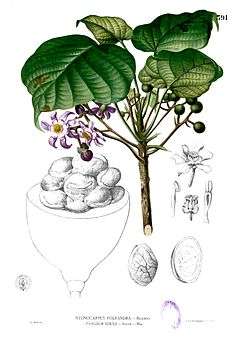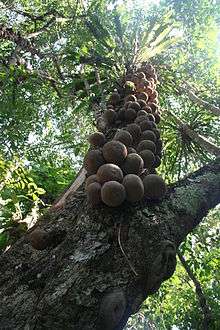Achariaceae
Achariaceae is a family of flowering plants consisting of 32-33 genera with about 155 species[2] of tropical herbs, shrubs, and trees. The APG IV system has greatly expanded the scope of the family by including many genera previously classified in Flacourtiaceae.[3] Molecular data strongly support the inclusion of this family in the order Malpighiales.
| Achariaceae | |
|---|---|
 | |
| Pangium edule | |
| Scientific classification | |
| Kingdom: | Plantae |
| Clade: | Tracheophytes |
| Clade: | Angiosperms |
| Clade: | Eudicots |
| Clade: | Rosids |
| Order: | Malpighiales |
| Family: | Achariaceae Harms[1] |
| Type genus | |
| Acharia | |
The family is almost exclusively tropical and is best known as the source of chaulmoogra oil, formerly used to treat leprosy. Unlike other members of the former Flacourtiaceae now placed in the family Salicaceae, the genera of Achariaceae typically have cyanogenic glycosides.
Genera

Gynocardia odorata, an evergreen tree from South Asia
- Acharia
- Baileyoxylon
- Buchnerodendron
- Caloncoba
- Camptostylus
- Carpotroche
- Ceratiosicyos
- Chiangiodendron
- Chlorocarpa
- Dasylepis
- Eleutherandra
- Erythrospermum
- Grandidiera
- Guthriea
- Gynocardia
- Hydnocarpus
- Kiggelaria
- Kuhlmanniodendron[4]
- Lindackeria
- Mayna
- Mocquerysia
- Pangium
- Peterodendron
- Phyllobotryon
- Phylloclinium (sometimes included in Phyllobotryon)[5]
- Poggea
- Prockiopsis
- Rawsonia
- Ryparosa
- Scaphocalyx
- Scottellia
- Trichadenia
- Xylotheca
gollark: It might be more efficient in *yours*, sound, to only bother checking the first two characters of each subthing of user input.
gollark: Also, `c=s[i]` should go above `if s[i]=="i"` and this should be `if c=="i"`, I think.
gollark: If you factor in the size of doing all the indents it might be cheaper to do `s=input()` rather than making a function..
gollark: Just brotlipython it.
gollark: I don't see how this line works though: `if c in"ae":a+=int(c=="a")`. I mean, it doesn't look like it would decrement the accumulator at all.
References
- Angiosperm Phylogeny Group (2009). "An update of the Angiosperm Phylogeny Group classification for the orders and families of flowering plants: APG III". Botanical Journal of the Linnean Society. 161 (2): 105–121. doi:10.1111/j.1095-8339.2009.00996.x.
- Christenhusz, M. J. M. & Byng, J. W. (2016). "The number of known plants species in the world and its annual increase". Phytotaxa. 261 (3): 201–217. doi:10.11646/phytotaxa.261.3.1.
- Chase, Mark W.; Sue Zmarzty; M. Dolores Lledó; Kenneth J. Wurdack; Susan M. Swensen; Michael F. Fay (2002). "When in doubt, put it in Flacourtiaceae: a molecular phylogenetic analysis based on plastid rbcL DNA sequences". Kew Bulletin. 57 (1): 141–181. doi:10.2307/4110825. JSTOR 4110825.
- Fiaschi, Pedro; Groppo, Milton (2008). "Kuhlmanniodendron Fiaschi & Groppo, a new eastern Brazilian genus of Achariaceae sensu lato segregated from Carpotroche Endl. (formerly included in Flacourtiaceae)". Botanical Journal of the Linnean Society. 157 (1): 103–109. doi:10.1111/j.1095-8339.2007.00761.x. Retrieved 12 July 2018.
- Hul, S. (1991). "Révision des Flacourtiaceae-Phyllobotryoneae d'Afrique". Bulletin du Muséum National d'Histoire Naturelle, 4e Ser., Section B, Adansonia. 13 (3–4): 155–165.
This article is issued from Wikipedia. The text is licensed under Creative Commons - Attribution - Sharealike. Additional terms may apply for the media files.